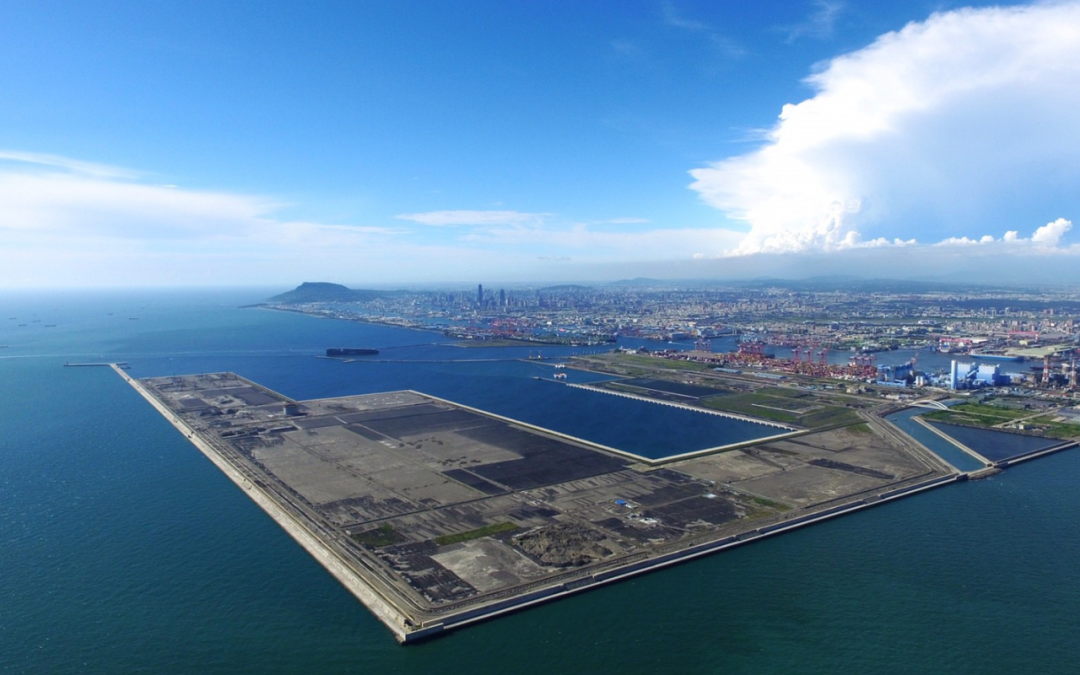The Port of Kaohsiung has been named the honored recipient of the 2021 World Ports Sustainability Program (WPSP) award for Resilient Physical Infrastructure. The WPSP award results were announced on June 24th by the International Association of Ports and Harbors (IAPH).
This year, Port of Kaohsiung represented Taiwan’s international commercial port group in IAPH’s WPSP award program, submitting its Master Plan for Future Development and Construction (2017-2021) for consideration in the “Resilient Physical Infrastructure” category. During the first round of judging (70% of the final score), the IAPH panel gave high marks to Port of Kaohsiung’s construction and environmental planning in Phase-2 of the Intercontinental Container Terminal (ICT) project and to the port’s development of Kao Port Park and construction of the Great Harbor Pedestrian Bridge. The panel score secured Port of Kaohsiung’s position as a top-three finalist alongside Australia’s Port of Brisbane and the United States’ Port of San Diego. The second round of judging (30% of the final score) tallied the results of online public voting. The votes submitted from around the world in favor of its entry were sufficient to push the Port of Kaohsiung ahead of its rivals, securing IAP’s declaration of Port of Kaohsiung as the 2021 WPSP Resilient Physical Infrastructure award category winner!
IAPH launched the World Ports Sustainability Program in 2018 to recognize the global leadership of ports in contributing to sustainable development in the following five facets: resilient physical infrastructure; climate and energy; health, safety, and security; community outreach and port-city dialogue; and governance and ethics. Each facet relates directly to the United Nations’ Sustainable Development Goals (SDGs) for 2030, and treats the port and overall environment as one. The Port of Kaohsiung submitted the Master Plan for Future Development and Construction (2017-2021) as the core of its submission for consideration for the 2021 WPSP Resilient Physical Infrastructure Award. This plan details the innovative and sustainable approaches taken in constructing the port’s new ICT in terms of new land reclamation, dredging and backfill, sand-extraction monitoring, energy and carbon reduction measures, green construction methods, and innovative workarounds for project bottlenecks, as well as the successes achieved in renovating and rejuvenating the port’s Old Port District.
The main objectives of Port of Kaohsiung’s most recent 5-year Master Plan were to address the pressing need to efficiently accommodate increasingly larger commercial vessels, to effectively service the evolving needs of domestic and international trade environments, and to relocate more than 300 petrochemical storage tanks and related facilities in the Old Port District away from downtown Kaohsiung City in order to facilitate the synergistic development of both port and city and consolidate/streamline key industry operations at the port. Thus, working to proactively resolve chronic, long-term differences between the port and city, Port of Kaohsiung initiated comprehensive plans to relocate highly polluting, highly dangerous petrochemical and heavy industrial operations from sections of the port adjacent to downtown Kaohsiung City to newly reclaimed land along the Taiwan Strait. In addition, green and eco-friendly construction methods were used in the construction of new port facilities, a segregation strategy was implemented for arriving and departing vessels, and state-of-the-art environmental protection facilities were installed. Furthermore, the Old Port District was revitalized and reinvigorated via projects such as KW2, Kao Port Park, and the Great Harbor Pedestrian Bridge, creating new, vibrant links between port and city. The port’s Master Plan and associated action items thus paved the way forward for continued commercial and industrial development at the port while bringing port and city closer together and creating new, blue horizons for port-city cooperation and mutual prosperity.
The Port of Kaohsiung ICT project is Taiwan’s largest maritime engineering project in recent decades, with major related components including construction of an outer breakwater, coastal berths, and reclaimed land. In line with eco-sustainability principles, the ICT project incorporates key water ecology protection / conservation initiatives. The completed ICT will provide multiple new, deep-water wharves able to handle the world’s largest container ships, add significant new land area for associated commercial activity, resolve the port’s need for land to relocate near-city petrochemical storage tanks, and significantly streamline general port operations. Overall, these changes are advancing the Port of Kaohsiung further toward striking an optimal, ‘eco-port’ balance among the priorities of industry, society, and environmentally sustainable development. Importantly, Port of Kaohsiung’s Master Plan for Future Development and Construction (2017-2021) solidly hits a number of United Nations’ Sustainable Development Goals, most notably including “Industry, Innovation and Infrastructure”, “Climate Action”, “Affordable and Clean Energy”, “Life Below Water”, “Life on Land”, “Sustainable Cities and Communities”, and “Good Health and Well-Being”.
In recent years, in addition to strategically diversifying its core operations, Port of Kaohsiung has placed significant emphasis on sustainable development and corporate social responsibility as part of a coordinated effort to become one of the world’s best-run ports. Beyond regularly maintaining ESPO EcoPorts certification, which it has consistently held since 2014, Port of Kaohsiung is deepening its eco-sustainability-related commitments and action. The results of this year’s IAPH WPSP awards program focus international recognition and affirmation on the practical results achieved by the environmental protection efforts of Taiwan’s ports. Many years of dedicated teamwork have led to today’s honor and given a global stage to the Port of Kaohsiung’s honest and effective efforts to promote environmental sustainability.
Source: Seatrade Maritime News






